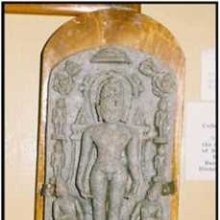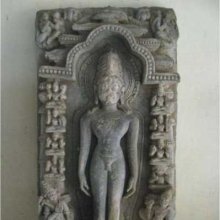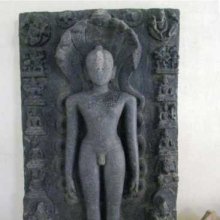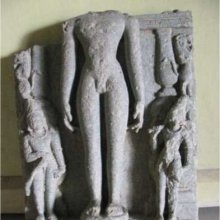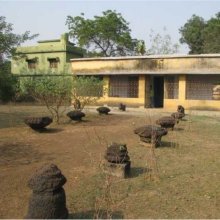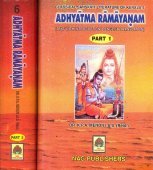Ayodhya, Ayodhyā: 26 definitions
Introduction:
Ayodhya means something in Hinduism, Sanskrit, Jainism, Prakrit, the history of ancient India, Marathi. If you want to know the exact meaning, history, etymology or English translation of this term then check out the descriptions on this page. Add your comment or reference to a book if you want to contribute to this summary article.
Images (photo gallery)
(+20 more images available)
In Hinduism
Vastushastra (architecture)
Source: Google Books: The Hindu Temple, Volume 1Ayodhyā (अयोध्या), the impregnable city of the gods, has eigth Cakras (‘cycles’). “The city of Ayodhyā” is of two kinds; with reference to man, the microcosm, and with reference to the universe, the macrocosm. In man, the Cakras lead from the Mūlādhāra, the seat of consciousness, to the Bindu-Trikoṇa or Śiva-Śakti, the Supreme Principle in the Sahasrāra. In the universe the eight cycles are those of the eight suns, presided over by the eight Ādityas.
Within Ayodhyā, is the golden compartment, ever illuminated by light. The centre is Brahmapura, the stronghold (pur) of Brahman. It corresponds to Brahmasthāna, in the centre of the Vāstupuruṣamaṇḍala. In the ‘Rāmāyaṇa’, the city of Ayodhyā is beheld as a square of 8 compartments of each side (aṣṭāpada).

Vastushastra (वास्तुशास्त्र, vāstuśāstra) refers to the ancient Indian science (shastra) of architecture (vastu), dealing with topics such architecture, sculpture, town-building, fort building and various other constructions. Vastu also deals with the philosophy of the architectural relation with the cosmic universe.
Purana and Itihasa (epic history)
Source: archive.org: Puranic EncyclopediaAyodhyā (अयोध्या).—A city in North India which enjoyed great importance and reputation for many years as the capital of the Kings of the solar dynasty. (See Ikṣvāku dynasty). All the Kings of this dynasty ruled the country from this city as their capital. Vasiṣṭha, the great preceptor of the Ikṣvāku Rājas, came to Ayodhyā during the period of the reign of Kalmāṣapāda, who was the thirtyfifth ruler in succession to Ikṣvāku. A quarrel broke out between Kalmāṣapāda and Vasiṣṭha during a hunting expedition, and Vasiṣṭha cursed the King and as the result the latter became a Rākṣasa. After regaining his former form as King, he apologised to Vasiṣṭha and they became friends again. At the request of the King in the interests of his dynasty Vasiṣṭha came to Ayodhyā, and the people were greatly elated. A son was born to Vasiṣṭha by Kalmāṣapāda’s wife and that son was Aśmaka. After that Vasiṣṭha used to go to Ayodhyā frequently and was installed as family preceptor of the Ikṣvākus. Till the time of Śrī Rāma the city of Ayodhyā maintained its pomp and glory, and after that gradually its decay and fall set in. Laudatory references to the city are found in most of the Purāṇas like the Mahābhārata, Brahmāṇḍa Purāṇa etc. (See Kosala).
Source: archive.org: Shiva Purana - English Translation1) Ayodhyā (अयोध्या) refers to one of the seven sacred cities of the Hindus, according to a footnote at the Śivapurāṇa-māhātmya chapter 1. Accordingly, —“[...] the holy rivers, Gaṅgā and others, the seven sacred cities [viz., Ayodhyā] and Gayā can never be equal to Śivapurāṇa. If one wishes for the greatest of goals (Liberation) one shall recite at least a stanza or even half of it from Śivapurāṇa. He who constantly listens to Śivapurāṇa fully comprehending its meaning or simply reads it with devotion is undoubtedly a meritorious soul”.
The seven sacred cities of the Hindus are: Ayodhyā, Mathurā, Māyā, Kāśī, Kāñcī, Āvantikā and Dvārikā.
2) Ayodhyā (अयोध्या) is the name of a ancient country/region from where the Rudrākṣa trees are said to be very sacred, according to the Śivapurāṇa 1.25, while explaining the greatness of Rudrākṣa:—“[...] Rudrākṣas grown in Gauḍa land became great favourites of Śiva. They were grown in Mathurā, Laṅkā, Ayodhyā, Malaya, Sahya mountain, Kāśī and other places. They are competent to break asunder the clustered sins unbearable to the others, as the sacred texts have declared”.
Source: Cologne Digital Sanskrit Dictionaries: The Purana IndexAyodhyā (अयोध्या).—The capital of Ikṣvākus. The children of Ayodhyā were cast into the Sarayū by Asamañjasa and then restored to life by his yogic power.1 Chief buildings were prāsāda, gopura, sabhā, caitya and devagṛha;2 one of the holy cities.3 City of Rama and Sagara;4 also known as Śāketa.5 Capital of Madhyadeśa of King Divākara, famous for Rāmatīrtham;6 in the nose portion of the personified Veda.7
- 1) Bhāgavata-purāṇa IX. 8. 17-19.
- 2) Ib. IX. 11. 25-34; Brahmāṇḍa-purāṇa III. 63. 21;
- 3) Brahmāṇḍa-purāṇa IV. 40. 91.
- 4) Brahmāṇḍa-purāṇa III. 37. 33; 47. 75; 48. 1; 49. 10 and 58; 53. 5.
- 5) Brahmāṇḍa-purāṇa III. 54. 54.
- 6) Matsya-purāṇa 191. 93; 271. 5. Viṣṇu-purāṇa IV. 4. 97; Vāyu-purāṇa 99. 282.
- 7) Vāyu-purāṇa 88. 20, 94; 104. 81: 111. 68.
Ayodhyā (अयोध्या) is a name mentioned in the Mahābhārata (cf. II.27.2) and represents one of the many proper names used for people and places. Note: The Mahābhārata (mentioning Ayodhyā) is a Sanskrit epic poem consisting of 100,000 ślokas (metrical verses) and is over 2000 years old.
Source: Shodhganga: Temples and cult of Sri Rama in TamilnaduAyodhya or Ayotti refers to one of the 108 divyadesas according to Priyavaccan Pillai’s compendium of the Ramayana based on the Nalayirativviyappirapantam.—Ayotti (Ayodhya) is the most controversial venue on earth as a center of the Rama Cult. The Ramanayas, in all languages, claim Ayodhya to be the birth place of Rama. Nobody could dispute the thesis. If the question is the mandir or masjid (mosque), we will have to decide first who (Rama or Babar) was earlier in point of time. The simple fact is that Islam, as a religion, did not exist at the time of Rama-rajya. Ayodhya, Rama and Sita appear in Tamil literature since the Cankam Age (cf. Purananuru). No other remark is possible within the historical perspective of Ayodhya and Rama and not to speak of Babar.

The Purana (पुराण, purāṇas) refers to Sanskrit literature preserving ancient India’s vast cultural history, including historical legends, religious ceremonies, various arts and sciences. The eighteen mahapuranas total over 400,000 shlokas (metrical couplets) and date to at least several centuries BCE.
Kavya (poetry)
Source: Wisdom Library: KathāsaritsāgaraAyodhyā (अयोध्या) is the name of an ancient city, according to the Kathāsaritsāgara, chapter 69. Accordingly, “... there is a city of the name of Ayodhyā famous in the three worlds”. According to chapter 88: “there is a city of the name of Ayodhyā, which was the capital of Viṣṇu, when he was incarnate as Rāma, the destroyer of the Rākṣasa race”.
The Kathāsaritsāgara (‘ocean of streams of story’), mentioning Ayodhyā, is a famous Sanskrit epic story revolving around prince Naravāhanadatta and his quest to become the emperor of the vidyādharas (celestial beings). The work is said to have been an adaptation of Guṇāḍhya’s Bṛhatkathā consisting of 100,000 verses, which in turn is part of a larger work containing 700,000 verses.
Source: Shodhganga: The Kavyamimamsa of RajasekharaAyodhyā (अयोध्या) is the name a locality mentioned in Rājaśekhara’s 10th-century Kāvyamīmāṃsā.—This is situated on the river Sarayū in the united provinces.

Kavya (काव्य, kavya) refers to Sanskrit poetry, a popular ancient Indian tradition of literature. There have been many Sanskrit poets over the ages, hailing from ancient India and beyond. This topic includes mahakavya, or ‘epic poetry’ and natya, or ‘dramatic poetry’.
Vaishnavism (Vaishava dharma)
Source: Acta Orientalia vol. 74 (2013): Historical sequence of the Vaiṣṇava DivyadeśasAyodhyā (Ayoṭṭi) refers to one of the 108 Vaishnava Divya Desam (divyadeśas or divyasthalas), located in the topographical division of Vaṭanāṭu (“North India”), according to the 9th century Nālāyirativviyappirapantam (shortly Nālāyiram).—Tradition would record the Vaiṣṇava divyadeśas or divyasthalas are 108. The divyadeśa is a base of the cult of Viṣṇu in Viṣṇuism [Vaiṣṇavism] tradition. The list of 108 [viz., Ayodhyā] seems to have reached maturation by about the early 9th century CE as all the deśas are extolled in the hymns of the twelve Āḻvārs.
Source: Pure Bhakti: Brhad BhagavatamrtamAyodhyā (अयोध्या) refers to:—The capital of the dynasty of Śrī Rāma; a city, holy to devotees of Śrī Rāma, located in Uttar Pradesh, North India; a realm in Vaikuṇṭha, the spiritual world. (cf. Glossary page from Śrī Bṛhad-bhāgavatāmṛta).

Vaishnava (वैष्णव, vaiṣṇava) or vaishnavism (vaiṣṇavism) represents a tradition of Hinduism worshipping Vishnu as the supreme Lord. Similar to the Shaktism and Shaivism traditions, Vaishnavism also developed as an individual movement, famous for its exposition of the dashavatara (‘ten avatars of Vishnu’).
General definition (in Hinduism)
Source: WikiPedia: HinduismAyodhya is one of seven holy places for Hindus in India, with Varanasi the most sacrosanct. Ayodhya is believed to be the birthplace of Rama and setting of the epic Ramayana. It is adjacent to Faizabad city at south end in the Indian state of Uttar Pradesh. Ayodhya used to be the capital of the ancient Kosala Kingdom. It has an average elevation of 93 meters (305 feet).
In the Ramayana, it is described covering an area of 250 km2 (97 sq mi), and was capital of the Hindu kingdom Kaushal. It is on the banks of the Ganges, a river whose waters cleanse all sin, and on the right bank of Ghagra. The Ikshvaku of the solar clan (suryavansha) was its ruling dynasty.
In the Atharvaveda, Ayodhya was described as “made by Gods and prosperous as Heaven itself”.
In Jainism, Ayodhya has historical significance for the Jain community as well. It is the birthplace of two important tirthankaras two-thousand years ago. The Jain agamas also record the visit of Mahavira, the last tirthankara of Jainism. The city is also the birthplace of five Tirthankaras, including the first, Rishabha, and the ninth Ganadhara of Mahavira.
In Buddhism, the city is important in the heritage of Buddhism, with several Buddhist temples, monuments and centers of learning established here during the Mauryan Empire and Gupta Dynasty. Ayodhya reached its peak of trade during the Gupta dynasty.
In Jainism
General definition (in Jainism)
Source: archive.org: Sum Jaina Canonical Sutras (vividhatirthakalpa)Ayodhyā (अयोध्या) is known by such other names as Kosalā, Viṇītā, Sāketa, Ikṣvākubhūmi, Rāmapurī and Kośala and Ayodhyānagarī. It is the birth-place of Ṛṣabha, Ajita, Abhinandana, Sumati, Ananta and Acala Bhānu. It was the captial of Daśaratha, Rāma and Bharata. Seven family preceptors like Vimalavāhana were born here. Here the most devoted Sītā faced and withstood the fire-ordeal.
Ayodhyā is twelve yojanas long, and nine yojanas broad. Here Cakreśvarī and Gomukha Yakṣa removed the obstacles of the Saṃgha. Here the river Gharghara-daha meets with the Sarayū and is known by the name of Svargadvāra (gate of heaven). Twelve yojanas from this place is the Aṣṭāvata mountain, where Lord Ādiguru attained enlightenment.
Here still exists the temple of Nābhirāja. Pārśvanātha-vāṭikā (grove of Pārśvanātha), Sītākuṇḍa (a hot-spring) and Sahasradhārā (thousand streams) are to be seen here. On the rampart lies a Yakṣa, the lord of furious elephants. Even now elephants do not pass by it. Here are many popular shrines. Ayodhyā is watered by the river Sarayū.
Source: archive.org: Trisastisalakapurusacaritra1) Ayodhyā (अयोध्या) (also called Vinītā) is the name of a city created by Kubera, according to chapter 1.2 [ādīśvara-caritra] of Hemacandra’s 11th century Triṣaṣṭiśalākāpuruṣacaritra: an ancient Sanskrit epic poem narrating the history and legends of sixty-three illustrious persons in Jainism.
Accordingly, “[...] Kubera made the city Vinītā, also called Ayodhyā, twelve yojanas long and nine wide. After laying it out, the Yakṣa-king, free from deceit, filled it unceasingly with inexhaustible clothes, ornaments, money, and grain. Even without a wall (as background for painting) a painting was made in the sky from the variegated light from palaces of diamond, sapphire, and cat’s eye. In it the appearance of challenge-papers, as it were, to the peaks of Meru was made by the lofty golden palaces in the guise of banners. [...]”.
2) Ayodhyā (or Vinītā) is the birth-place of Ajita, Abhinandana and Ananta, the second, fourth and fourteenth Tīrthaṅkaras, according to chapter 1.6.

Jainism is an Indian religion of Dharma whose doctrine revolves around harmlessness (ahimsa) towards every living being. The two major branches (Digambara and Svetambara) of Jainism stimulate self-control (or, shramana, ‘self-reliance’) and spiritual development through a path of peace for the soul to progess to the ultimate goal.
India history and geography
Source: archive.org: Personal and geographical names in the Gupta inscriptionsAyodhyā (अयोध्या) or Ayodhyāvāsaka is a place-name classified as a vāsaka (abode or inhabitation) and mentioned in the Gupta inscriptions. The Gupta empire (r. 3rd-century CE), founded by Śrī Gupta, covered much of ancient India and embraced the Dharmic religions such as Hinduism, Buddhism and Jainism. Ayodhyā is described as a victorious camp, full of great ships, and elephants and horses.
Ayodhyā has been venerated as one of the most important and holy places of the Hindus. Vinītā was another name for this city. Its other names including Viṇīā (Vinītā) are mentioned in the Vividhatīrthakalpa (p. 29). Fa-Hsien calls it Sha-che and Ptolemy knew it as Sogeda. Ayodhyā and Sāketa have been treated by many writers as being identical. Csoma de koros calls this place as “Sāketan or Ayodhyā” and H. H. Wilson in his dictionary, refers to Sāketa as “the city of Ayodhyā”. Several passages in the Raghuvaṃśa (8.5.79) confirm it.The Vividhatīrthakalpa (p. 24) mentions Sākeyam (Sāketa) as asynonym for Ayodhyā, but in the Buddhist literature we find separate references to Ayodhyā and Sāketa which creates doubt about their identity and suggests that the two existed separately.
The ancient city of Ayodhyā or Sāketa is described in the Rāmāyaṇa as situated on the banks of the Sarayū or Sarjū river. During the Buddhist period, Ayodhyā was divided into Uttara (Northern) Kosala and Dakṣiṇa (Southern) Kosala.The river Sarayū was the dividing line between the two provinces. Ayodhyā was the capital of the latter. Ancient tradition believes it to have been built by Manu.
Source: academia.edu: Who was the Indian King Sandrokottus?Ayodhya is located 175 kms in the north of Prayag whereas Vindhyachal (Pāriyātra) and Shonabhadra are located within 100 kms in the South-east of Prayag. Greek historians refer to the river “Errannaboas”. In all probability, Errannaboas derived from Yamuna-Sarasvati. The Chinese translation of “Life of Vasubandhu” has assumed A-yu-ja to be Ayodhya. If we add “P”, it can be Pa-yu-ja or Prayaga. Thus, Pratishthanapura or Prayagabhadra or Ayodhya can be identified as Polibothra.
Source: Ancient Buddhist Texts: Geography of Early BuddhismAyodhyā seems to have been the earliest capital [of Kosala], and Sāketa the next. In Buddha’s time, Ayodhyā had sunk to the level of an unimportant town (Buddhist India, p. 34), but Sāketa and Sāvatthī (Śrāvastī) were two of the six great cities of India (cf. Mahāparinibbāna Sutta). Ayodhyā or Oudh was a town on the river Sarajū. Some think that Sāketa and Ayodhyā were identical, but Prof. Rhys Davids has been successful to point out that both cities were existing in the Buddha’s time. Besides Sāketa and Sāvatthī, there were other minor towns like Setavya (Pāyāsi Suttanta) and Ukkaṭṭha (Ambaṭṭha Sutta) included in Kosala proper.
Ayojjhā represents Sanskrit Ayodhyā of the Rāmāyaṇa and A-yu-te of Yuan Chwang who places it 600 li to the south-east of the neighbourhood of Navadevakula city identified with Newal in Unao district, U.P. Ayodhyā is only a mile from Fyzabad. The Janapada roughly corresponds to modern Oudh.

The history of India traces the identification of countries, villages, towns and other regions of India, as well as mythology, zoology, royal dynasties, rulers, tribes, local festivities and traditions and regional languages. Ancient India enjoyed religious freedom and encourages the path of Dharma, a concept common to Buddhism, Hinduism, and Jainism.
Languages of India and abroad
Marathi-English dictionary
Source: DDSA: The Molesworth Marathi and English Dictionaryayōdhyā (अयोध्या).—m The name of the capital of the dominions of daśaratha. Ex. kiṃ nāsikāvāñcuni vadana || ayōdhyābhuvana taisēṃ disē ||
Marathi is an Indo-European language having over 70 million native speakers people in (predominantly) Maharashtra India. Marathi, like many other Indo-Aryan languages, evolved from early forms of Prakrit, which itself is a subset of Sanskrit, one of the most ancient languages of the world.
Sanskrit dictionary
Source: DDSA: The practical Sanskrit-English dictionaryAyodhya (अयोध्य).—a. Not to be warred against, unassailable; irresistible; अद्यायोध्या महावाहो अयोध्या प्रतिभाति नः (adyāyodhyā mahāvāho ayodhyā pratibhāti naḥ) Rām.
-dhyā The capital of solar kings, born of the line of Raghu, (the modern Oudh) situated on the river Śarayu. अलमुपहितशोभां तूर्णमायादयोध्याम् (alamupahitaśobhāṃ tūrṇamāyādayodhyām) | Bk. [It is said to have extended 48 miles in length and 12 miles in breadth. It was also called Sāketa, and one of its suburbs was Nandi-grāma, where Bharata lived governing the kingdom during the absence of Rāma. The town plays an important part in the story of the Rāmāyaṇa; the second book (ayodhyākāṇḍa) dealing mostly with events that took place in that city during the youthful days of Rāma.]
Source: Cologne Digital Sanskrit Dictionaries: Shabda-Sagara Sanskrit-English DictionaryAyodhya (अयोध्य).—mfn.
(-dhyaḥ-dhyā-dhyaṃ) Not to be warred against. f.
(-dhyā) The capital of Rama, Ayod'hya, the modern Oude. E. a neg. yuddha to make war, and ṇyat aff.
Source: Cologne Digital Sanskrit Dictionaries: Cappeller Sanskrit-English DictionaryAyodhya (अयोध्य).—[adjective] unconquerable, invincible. [feminine] ā [Name] of a town.
Source: Cologne Digital Sanskrit Dictionaries: Monier-Williams Sanskrit-English Dictionary1) Ayodhya (अयोध्य):—[=a-yodhya] [from a-yuddha] mf(ā)n. (3, 4) not to be warred against, irresistible, [Atharva-veda; Rāmāyaṇa]
2) Ayodhyā (अयोध्या):—[=a-yodhyā] [from a-yodhya > a-yuddha] f. the capital of Rāma (the modern Oude on the river Sarayu described in [Rāmāyaṇa.i, 5]).
Source: Cologne Digital Sanskrit Dictionaries: Yates Sanskrit-English DictionaryAyodhya (अयोध्य):—[a-yodhya] (dhyaḥ-dhyā-dhyaṃ) a. Not to be warred against. (dhyā) f. Oude.
Source: DDSA: Paia-sadda-mahannavo; a comprehensive Prakrit Hindi dictionary (S)Ayodhya (अयोध्य) in the Sanskrit language is related to the Prakrit words: Aujjha, Aujjhā.
[Sanskrit to German]
Sanskrit, also spelled संस्कृतम् (saṃskṛtam), is an ancient language of India commonly seen as the grandmother of the Indo-European language family (even English!). Closely allied with Prakrit and Pali, Sanskrit is more exhaustive in both grammar and terms and has the most extensive collection of literature in the world, greatly surpassing its sister-languages Greek and Latin.
Kannada-English dictionary
Source: Alar: Kannada-English corpusAyōdhya (ಅಯೋಧ್ಯ):—[adjective] that cannot, must not, be fought with; not to be warred against; unassailable; irresistible.
--- OR ---
Ayōdhya (ಅಯೋಧ್ಯ):—[noun] name of one of the seven virtuous gems.
Kannada is a Dravidian language (as opposed to the Indo-European language family) mainly spoken in the southwestern region of India.
See also (Relevant definitions)
Starts with: Ayodhyadhipati, Ayodhyaka, Ayodhyakanda, Ayodhyakhanda, Ayodhyamahatmya, Ayodhyaparva, Ayodhyaprasada, Ayodhyavasaka, Ayodhyavasin.
Ends with: Cakrayodhya.
Full-text (+293): Saketa, Aujjha, Koshala, Uttarakoshala, Abhyayodhyam, Rituparna, Sagara, Ayodhyaka, Ayodhyavasin, Akrishashva, Ayodhyadhipati, Ayotti, Ayodhyakanda, Kaikeyi, Dasharatha, Viraketu, Setika, Kaushalya, Dirghayajna, Sarayu.
Relevant text
Search found 117 books and stories containing Ayodhya, Ayodhyā, Ayōdhyā, A-yodhya, A-yodhyā, Ayōdhya; (plurals include: Ayodhyas, Ayodhyās, Ayōdhyās, yodhyas, yodhyās, Ayōdhyas). You can also click to the full overview containing English textual excerpts. Below are direct links for the most relevant articles:
The Skanda Purana (by G. V. Tagare)
Section 8 - Ayodhyā-māhātmya < [Book 2 - Vaiṣṇava-khaṇḍa]
Chapter 1 - The Greatness of Viṣṇuhari < [Section 8 - Ayodhyā-māhātmya]
Chapter 10 - Pilgrimage to Ayodhyā < [Section 8 - Ayodhyā-māhātmya]
Brihad Bhagavatamrita (commentary) (by Śrī Śrīmad Bhaktivedānta Nārāyana Gosvāmī Mahārāja)
Verse 2.4.240 < [Chapter 4 - Vaikuṇṭha (the spiritual world)]
Verse 2.4.247 < [Chapter 4 - Vaikuṇṭha (the spiritual world)]
Verse 2.4.239 < [Chapter 4 - Vaikuṇṭha (the spiritual world)]
Garga Samhita (English) (by Danavir Goswami)
Verse 4.20.1 < [Chapter 20 - The Killing of Pralamba]
Verses 3.10.31-37 < [Chapter 10 - The Glory of Śrī Girirāja]
Verse 4.6.29 < [Chapter 6 - The Story of the Ayodhyā Women]
Jain Remains of Ancient Bengal (by Shubha Majumder)
The twenty-four Tīrthaṅkaras and their Yakṣas and Yakṣiṇīs < [Chapter 6 - Iconographic Study of Jaina Sculptural Remains]
Geographical as well as Geo-political unit of Zone II < [Chapter 2 - Geographical Setting of the Study Area]
Images of Tīrthaṅkara Ajitanātha < [Chapter 6 - Iconographic Study of Jaina Sculptural Remains]
Tiruvaymoli (Thiruvaimozhi): English translation (by S. Satyamurthi Ayyangar)
Pasuram 7.5.1 < [Section 5 - Fifth Tiruvaymoli (Karpar-irama-piranai)]
Pasuram 7.5.2 < [Section 5 - Fifth Tiruvaymoli (Karpar-irama-piranai)]
Pasuram 7.6.9 < [Section 6 - Sixth Tiruvaymoli (Pa maru muvulakum)]
Ramayana (by Manmatha Nath Dutt)
Chapter VI < [Book 1 - Bāla-kāṇḍa]
Chapter LXVII < [Book 1 - Bāla-kāṇḍa]
Chapter III < [Book 1 - Bāla-kāṇḍa]
Related products
